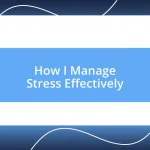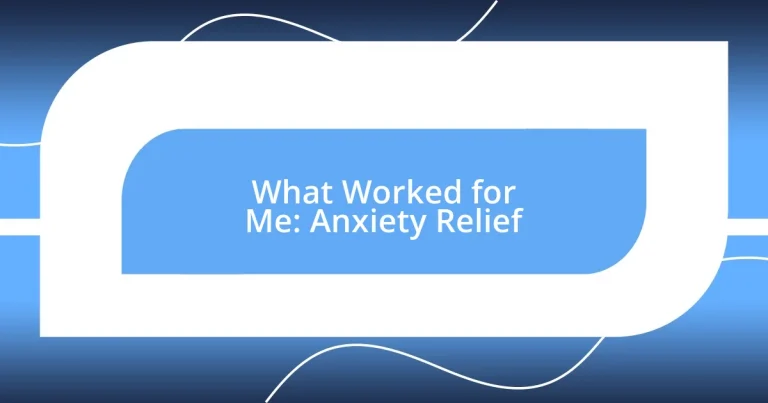Key takeaways:
- Exploring multiple anxiety relief techniques like breathing exercises, support groups, and mindfulness practices led to personal insights and a stronger self-understanding.
- Creating a support system and developing healthy routines provided essential comfort and coping strategies, transforming anxiety management from a solitary fight to a shared journey.
- Regularly evaluating progress through journaling and checklists revealed patterns in mental health, fostering resilience and encouraging positive changes in coping strategies.
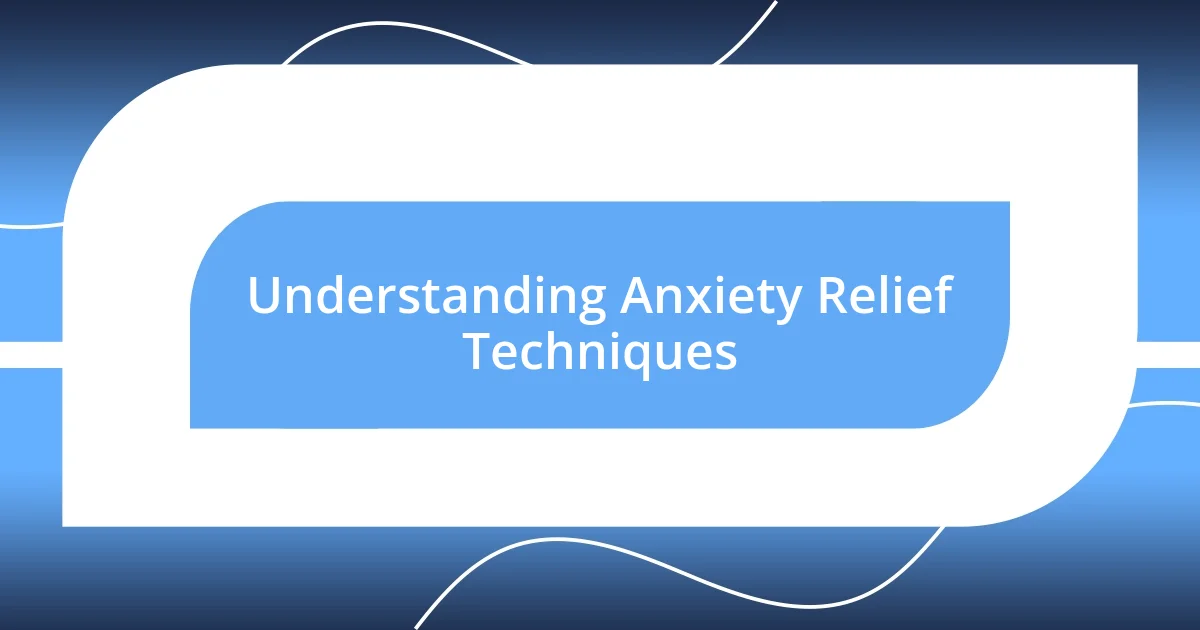
Understanding Anxiety Relief Techniques
When I first started exploring anxiety relief techniques, it felt overwhelming. There are so many options out there—meditation, exercise, therapy, and more. I often asked myself, “Which method would actually work for me?” This journey definitely taught me that understanding myself was just as important as understanding the techniques.
I remember a time when I struggled to calm my racing thoughts. I tried deep breathing, but it was honestly the simple act of stepping outside into the fresh air that grounded me. Feeling the cool breeze against my skin sparked a realization: sometimes, it’s the most straightforward techniques that can bring profound relief. Have you ever noticed how a change of scenery can shift your perspective?
The emotional weight of anxiety can be crippling, and seeking relief is a personal and unique journey. I found that journaling was a powerful tool; pouring my thoughts onto paper helped me process my emotions more clearly. This revelation made me ponder, “What if sharing these feelings could lead to understanding and connection?” That question drove me to explore community support, which I now see as essential in managing anxiety.
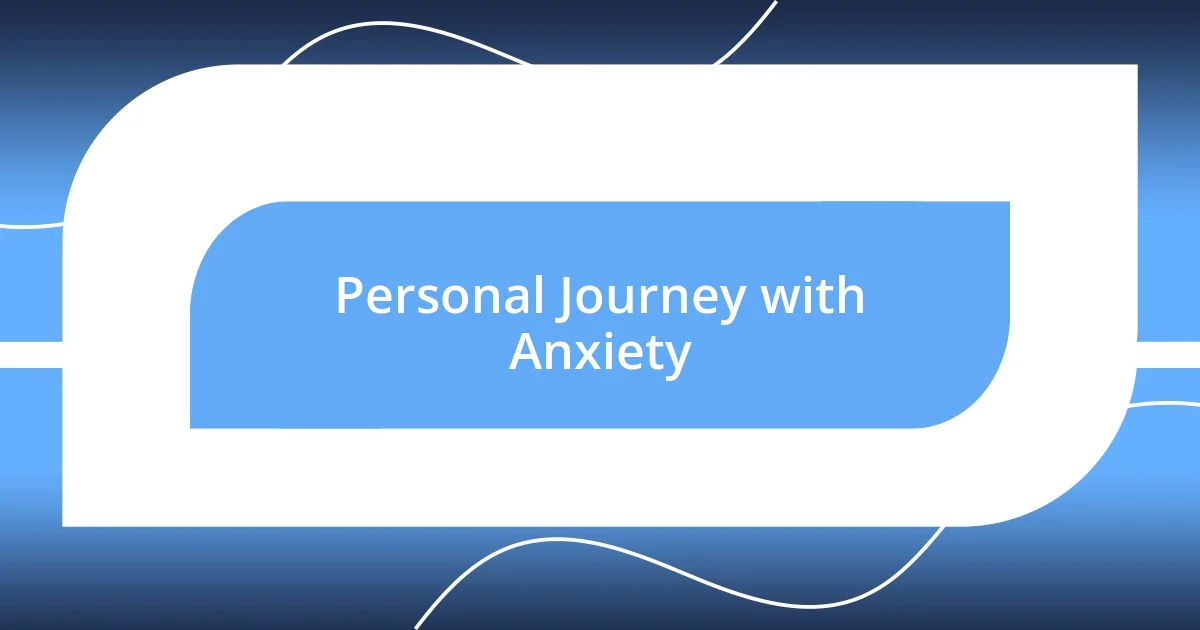
Personal Journey with Anxiety
I vividly recall the first time I attended a support group. At first, I was apprehensive, feeling like an outsider among the worried faces. But once I started sharing my experiences, an amazing thing happened—I realized others felt the same way. This connection fostered a sense of belonging that I hadn’t anticipated, and it was a pivotal moment in my journey.
Meditation was another technique I stumbled upon rather unexpectedly. Initially, I was skeptical about sitting in silence, thinking, “How can this possibly help?” But as I practiced mindfulness, I discovered clarity in the chaotic whirlwind of my thoughts. I can still remember the lingering calm after my first session—like stepping out of a noisy cafe into a quiet library. It changed my perception of control.
Reflecting on daily habits, I made a conscious choice to incorporate movement into my routine. At first, it was a simple walk around my neighborhood. I found joy in watching the seasons change—the tree buds in spring mirrored my step towards healing. Every step felt like shedding a layer of anxiety, and I realized that engaging with nature not only lifted my spirits but also allowed me to reconnect with my surroundings in a meaningful way.
| Technique | Personal Insight |
|---|---|
| Support Groups | Fostering connection through shared experiences can significantly ease feelings of isolation. |
| Meditation | Mindfulness can clarify chaotic thoughts, providing an unexpected sense of control. |
| Physical Activity | Simple movements in nature can enhance mood and promote a deeper connection with the environment. |
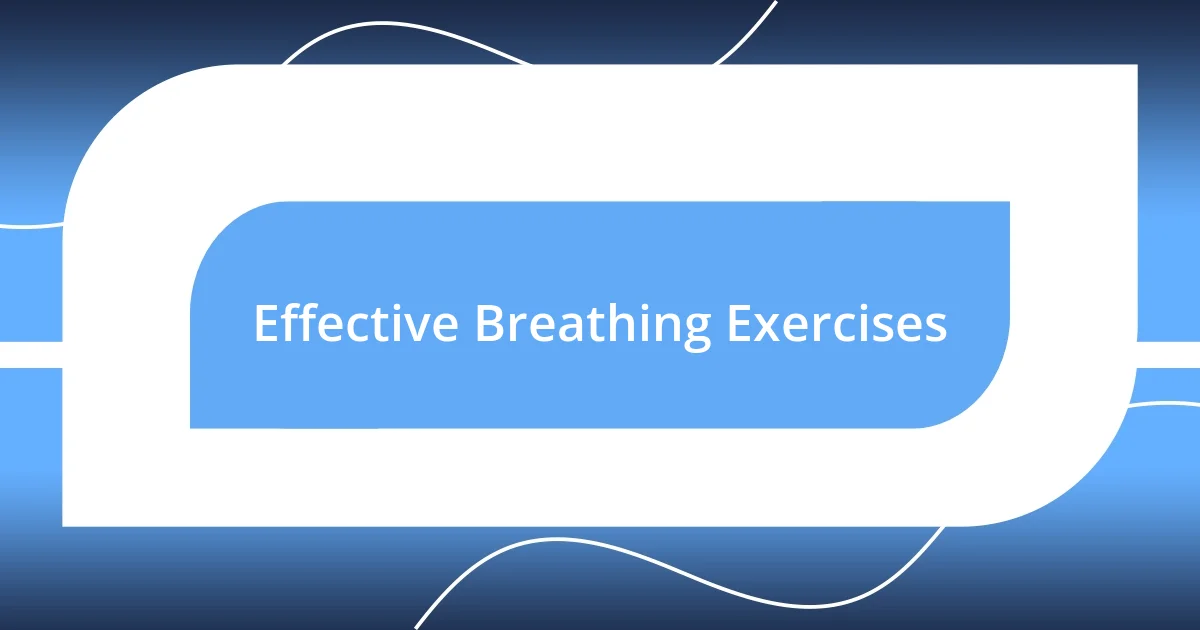
Effective Breathing Exercises
Breathing exercises have been a game-changer for me when managing anxiety. At first, I was skeptical, thinking, “Can simply breathing really make a difference?” Yet, I discovered a profound sense of calm through techniques like the 4-7-8 method. By inhaling for four counts, holding for seven, and exhaling for eight, I found that this rhythmic pattern not only grounds me but also slows down my racing mind. It’s amazing how just a few moments of focused breathing can create a sense of peace.
Here are a few effective breathing exercises that I incorporate into my daily routine:
-
Diaphragmatic Breathing: Lie down comfortably and place one hand on your chest and the other on your stomach. Inhale deeply through your nose, focusing on expanding your diaphragm rather than your chest.
-
Box Breathing: Breathe in for a count of four, hold for four, exhale for four, and pause for another four. This method works wonders to rebalance my emotions, especially during stressful moments.
-
Alternate Nostril Breathing: This technique involves closing one nostril, inhaling deeply, and then switching sides for the exhale. It’s surprisingly centering and has become my go-to anxiety buster.
What strikes me about these exercises is how accessible they are. They remind me that taking control of my breath means taking control of my mind. There were days when a handful of deep breaths turned a panic attack into a manageable moment, allowing me to regain my focus. I hope you find the same relief I did; it’s all about discovering what works uniquely for you.
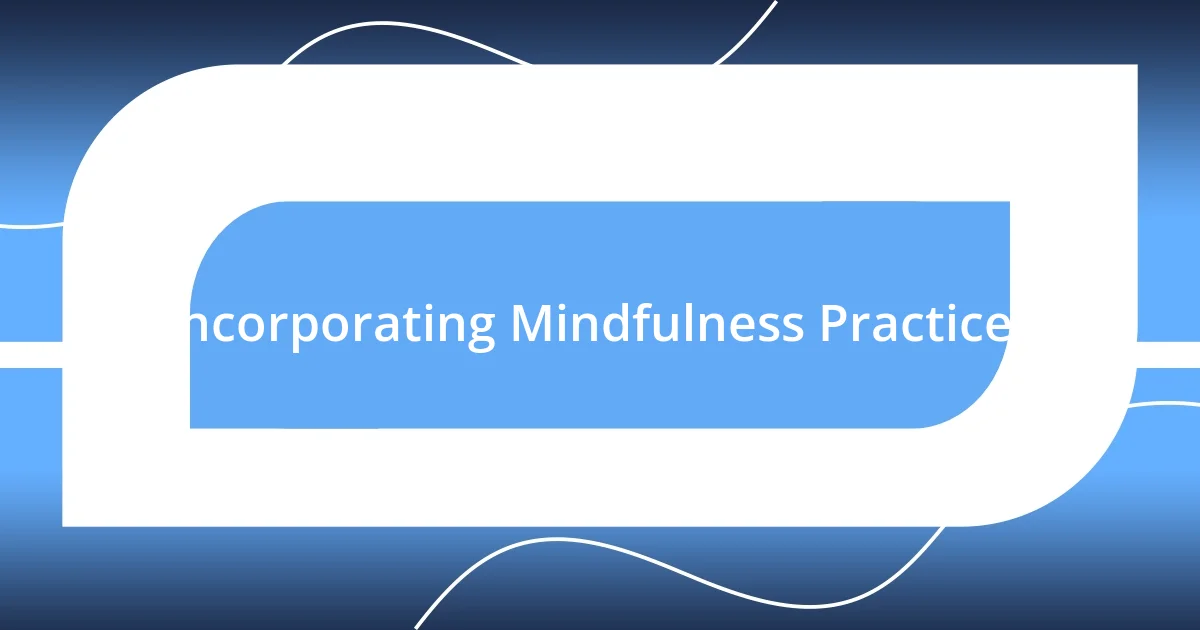
Incorporating Mindfulness Practices
Incorporating mindfulness practices into my daily routine was like finding a hidden gem that surprisingly transformed my mental landscape. I remember the first time I intentionally focused on being present; I was washing the dishes and deliberately paid attention to the warm water and the scent of the soap. It was such a simple act, but I felt an overwhelming sense of peace wash over me, as if all my worries had momentarily taken a backseat. Have you ever noticed how tuning into mundane tasks can bring unexpected clarity?
I also started exploring mindfulness meditation more seriously, setting aside just ten minutes each morning. Initially, my mind would swirl with a million distractions, but gradually, patience became my ally. Now, I find that those few moments of stillness not only ground me but also create a spaciousness in my mind for better problem-solving throughout the day. It’s fascinating how what once felt futile has now evolved into an essential part of my mental toolkit.
One of the most eye-opening exercises for me was body scanning. Laying down and mentally journeying through each part of my body revealed areas of tension I never realized I was holding onto. As I focused on releasing that tension, I felt lighter, almost luminous. I often wonder, if more people engaged in such practices, would they discover their own hidden stress markers? Personal insights like this help me remember that mindfulness is not just a practice; it’s a continual journey toward self-discovery and acceptance.
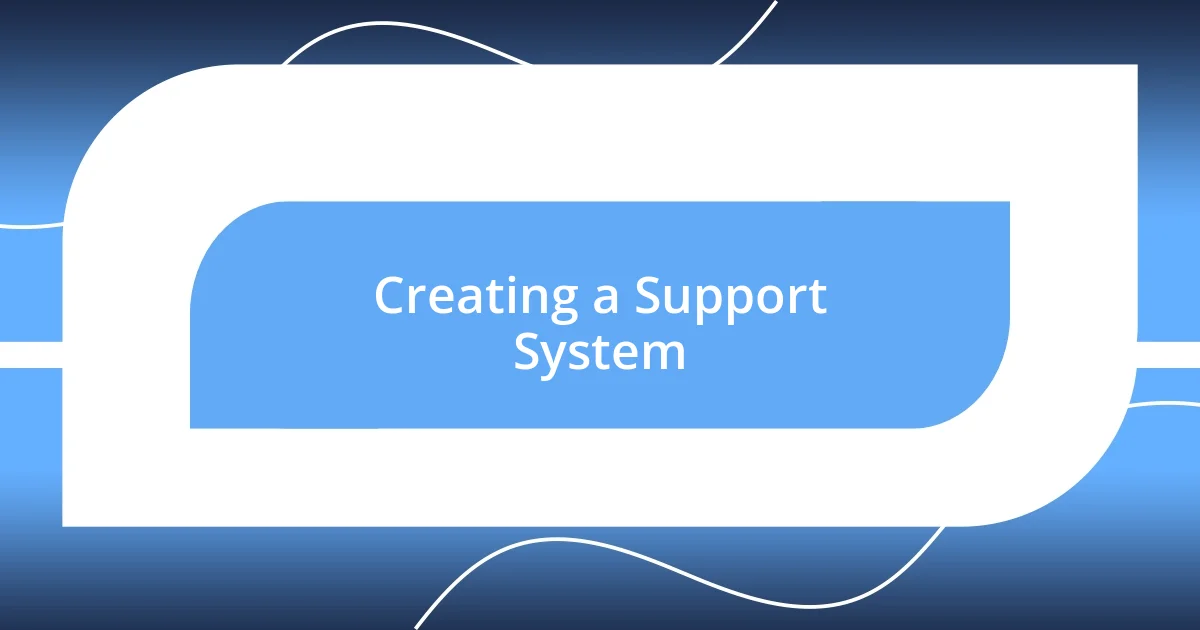
Creating a Support System
Creating a strong support system has been a crucial component of managing my anxiety. I can vividly recall the day I reached out to a friend who I knew had struggled with similar feelings. Our conversation not only validated my experiences but also reminded me that I wasn’t alone. Does anyone else find that simply sharing your feelings can lighten the load? It was a revelation; this connection transformed my anxiety from a solitary battle into a shared journey.
One early lesson I learned was the importance of surrounding myself with understanding individuals. I made a point to connect with friends who truly listened, offering empathy rather than judgment. For instance, when I shared my fears about an upcoming event, one friend shared her own anxious moments, which opened the door for a deeper conversation. Have you ever noticed how powerful it is when someone says, “I get it”? Those few words can create an instant bond, making it easier to face daily challenges together.
Developing a reliable support network has not only provided me with comfort but also equipped me with practical tools. I found that checking in on friends and family occasionally also worked wonders. By fostering mutual support, we create a space where we can share coping strategies and even light-hearted distractions. It’s fascinating how support can be a two-way street, enriching both our lives and helping us navigate anxiety more effectively. It’s safe to say I’ve learned that asking for help is a strength, not a weakness. Whether it’s joining a group or simply reaching out over coffee, building that network has made a world of difference for me.
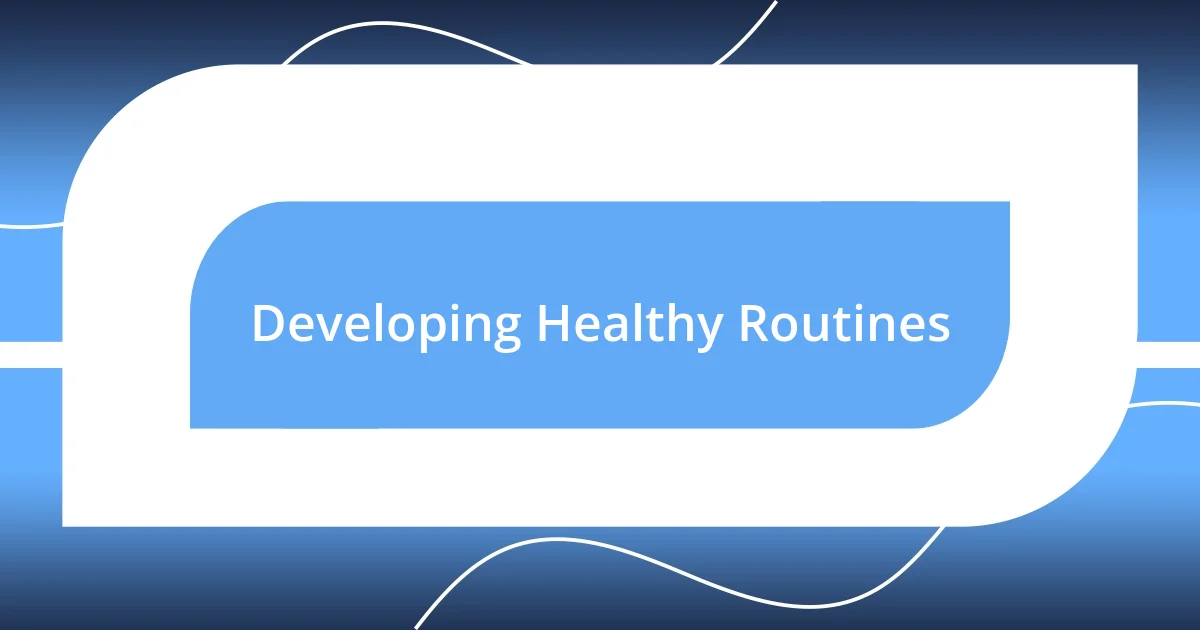
Developing Healthy Routines
Establishing healthy routines has been a game changer for my anxiety management. I remember the early mornings when I would wake up feeling heavy with anxious thoughts, unsure of how to sift through them. However, dedicating just a few minutes each day to structured habits, like stretching and sipping herbal tea, helped me carve out a comforting space. Isn’t it amazing how simple actions can set the tone for the rest of the day? Transitioning to a more mindful morning has undeniably reduced my overall stress.
Consistency, I’ve found, is key in developing these routines. I made a commitment to my evening wind-down ritual, which involves reading a few chapters of a book rather than scrolling on my phone. The shift from blue light to soothing pages not only signals my brain that the day is coming to a close, but it also fosters a tranquil mindset. Have you ever felt how a good book can whisk you away from your worries, even just for a little while? It was during those quiet moments, cocooned in a favorite blanket, that I started acknowledging how much calmer I felt when I prioritized this time for myself.
Working out has also played a pivotal role in my routine. Initially, I dreaded the thought of exercising, but finding an enjoyable activity, like dancing or brisk walking, transformed that dread into a source of joy. It’s incredible how movement not only releases those feel-good endorphins but also grounds me in the present moment. Have you felt that rush after a good session? It’s as if a weight has been lifted. Making these healthy routines a priority helped me create a reliable structure, allowing me to confront life’s unpredictability with a little more confidence.
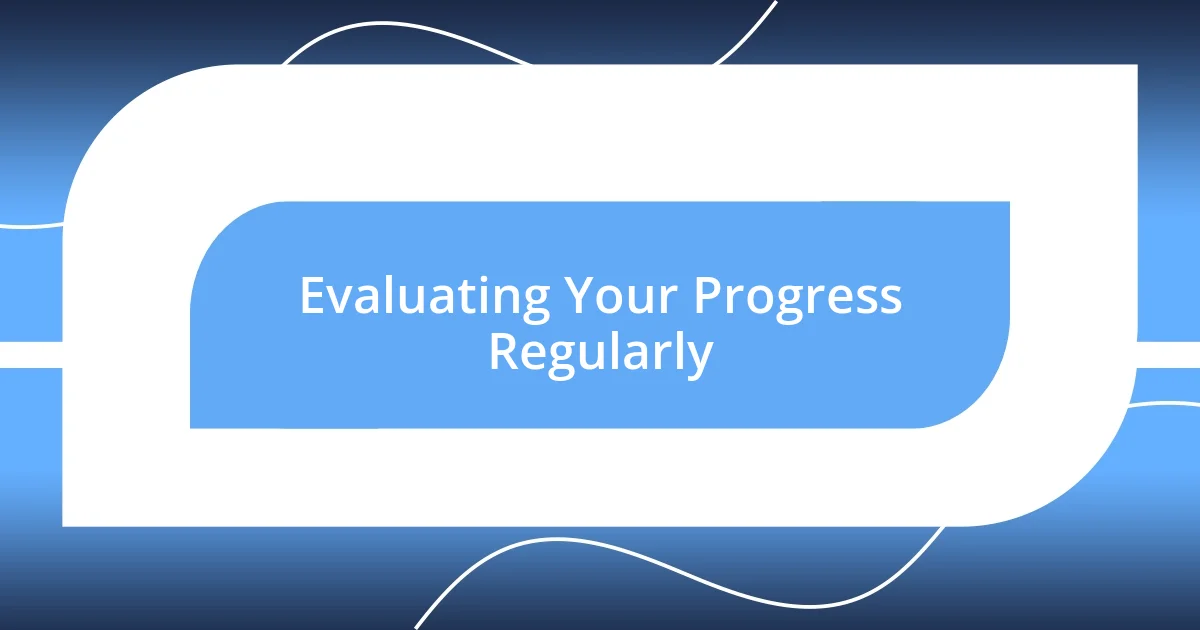
Evaluating Your Progress Regularly
Evaluating progress regularly in managing anxiety has been a game changer for me. I used to just push through my feelings without taking stock, and that only led to frustration. Now, I’ve started setting aside time each week to reflect on my experiences. Have you ever taken a moment to sit down and truly assess how you’re feeling? It can be quite illuminating; those quiet moments often reveal patterns I wasn’t even aware of.
I remember a particular weekend when I decided to journal about my anxiety over the past month. To my surprise, I discovered I was making strides in some areas while feeling stuck in others. This insight motivated me to adjust my coping strategies. It’s fascinating how writing things down can transform a chaotic mind into a clearer roadmap. I often remind myself that self-evaluation isn’t about criticism; it’s about celebrating victories and addressing challenges head-on.
One technique that’s worked well for me is creating a simple progress checklist. Each time I tick off a small achievement—whether it’s completing a meditation session or having a tough conversation—I feel a sense of accomplishment. Ever noticed how these small wins can boost your morale? Each tick not only serves as a reminder of progress but also fosters a positive mindset that propels me forward. Evaluating my journey has become an empowering ritual, one that reinforces my resilience against anxiety.









